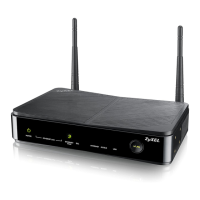SBG3300-N Series User’s Guide 277
CHAPTER 20
IPSec VPN
20.1 Overview
A virtual private network (VPN) provides secure communications between sites without the expense
of leased site-to-site lines. A secure VPN is a combination of tunneling, encryption, authentication,
access control and auditing. It is used to transport traffic over the Internet or any insecure network
that uses TCP/IP for communication.
Internet Protocol Security (IPSec) is a standards-based VPN that offers flexible solutions for secure
data communications across a public network like the Internet. IPSec is built around a number of
standardized cryptographic techniques to provide confidentiality, data integrity and authentication
at the IP layer.
The following figure provides one perspective of a VPN tunnel.
Figure 115 IPSec VPN: Overview
The VPN tunnel connects the Device (X) and the remote IPSec router (Y). These routers then
connect the local network (A) and remote network (B).
20.2 What You Can Do in this Chapter
•Use the Setup screen to display and manage the Device’s IPSec VPN rules (tunnels) (Section
20.4 on page 278).
•Use the Monitor screen to display and manage active IPSec VPN connections (Section 20.5 on
page 287).
•Use the Radius screen to manage the list of RADIUS servers the Device can use in
authenticating users (Section 20.6 on page 287).
VPN Tunnel
X
Y
Network A Network B

